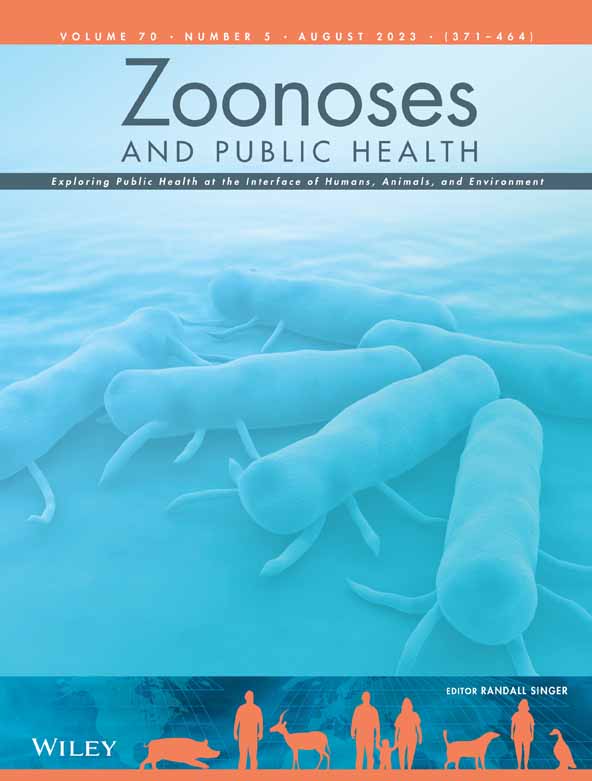View Item
- xmlui.general.dspace_homeCentros e Institutos de InvestigaciónCICVyA. Centro de Investigación en Ciencias Veterinarias y AgronómicasInstituto de PatobiologíaArtículos científicosxmlui.ArtifactBrowser.ItemViewer.trail
- DSpace Home
- Centros e Institutos de Investigación
- CICVyA. Centro de Investigación en Ciencias Veterinarias y Agronómicas
- Instituto de Patobiología
- Artículos científicos
- View Item
Rats as sources of multidrug-resistant Enterobacteriaceae in animal production environments
Abstract
Rattus norvegicus and Rattus rattus are commensal pest rodents, considered reservoirs and vectors of zoonotic pathogens. In livestock farms, the wide use of antimicrobials and their release into the environment lead to high long-term residual concentrations, which may in turn lead to the occurrence of antimicrobial resistance (AMR). Farm environments serve as AMR sources, resulting in the transmission of antimicrobial-resistant bacteria and their AMR
[ver mas...]
Rattus norvegicus and Rattus rattus are commensal pest rodents, considered reservoirs and vectors of zoonotic pathogens. In livestock farms, the wide use of antimicrobials and their release into the environment lead to high long-term residual concentrations, which may in turn lead to the occurrence of antimicrobial resistance (AMR). Farm environments serve as AMR sources, resulting in the transmission of antimicrobial-resistant bacteria and their AMR genes of livestock origin into wildlife. This study aimed to analyse the profile of enterobacteria carrying AMR determinants in rats captured in livestock farms to determine their potential vectors as for the spread of AMR. To this end, 56 rats (52 R. norvegicus and 4 R. rattus) were live-trapped on 11 farms (pig, dairy, poultry and mixed farms) located in central Argentina, from spring 2016 to autumn 2017. From 50 of the R. norvegicus individuals and three of the R. rattus individuals found in 10 of the farms, we isolated 53 Escherichia coli and five Salmonella strains. Susceptibility to antimicrobials, genotypic profiles, minimal inhibitory concentration of colistin and the presence of mcr-1 and genes encoding extended-spectrum β-lactamase (ESBL) were determined. Of the 58 isolates not susceptible to different antimicrobial classes, 28 of the E. coli strains and two of the Salmonella strains were defined as multi-drug resistant (MDR). S. Westhampton and S. Newport recovered were not susceptible to ampicillin or all the cephems tested. One of the E. coli obtained showed resistance to colistin and harboured the mcr-1 gene, demonstrated by PCR and conjugation. In two ESBL-producing Salmonella isolated from rats, CTX-M-2 genes were responsible for the observed resistance to third-generation cephalosporins. The MDR E. coli isolates showed several different resistance patterns (23), although some of them were the same in different individuals and different farms, with six resistance patterns, evidencing the dispersion of strains. These findings suggest that rats play a role in the dissemination of AMR determinants between animal, humans and environmental reservoirs.
[Cerrar]

Author
Dominguez, Johanna Elizabeth;
Lovera, Rosario;
Sánchez, Juliana;
Redondo, Leandro Martin;
Chacana, Pablo;
Cavia, Regino;
Fernandez Miyakawa, Mariano Enrique;
Fuente
Zoonoses and Public Health : 1-9 (First published: 04 July 2023)
Date
2023-07
Editorial
Wiley
ISSN
1863-2378
Documentos Relacionados
Formato
pdf
Tipo de documento
artículo
Proyectos
(ver más)
INTA/PNSA-1115056/AR./Enfermedades infecciosas de las aves.
Palabras Claves
Derechos de acceso
Restringido
 Excepto donde se diga explicitamente, este item se publica bajo la siguiente descripción: Creative Commons Attribution-NonCommercial-ShareAlike 2.5 Unported (CC BY-NC-SA 2.5)
Excepto donde se diga explicitamente, este item se publica bajo la siguiente descripción: Creative Commons Attribution-NonCommercial-ShareAlike 2.5 Unported (CC BY-NC-SA 2.5)


